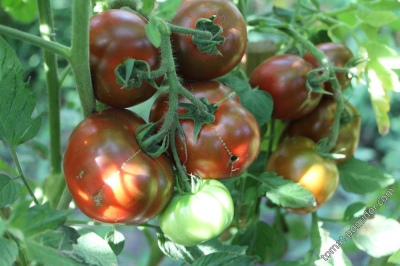
- Appeared when crossing: obtained from random pollination of Captain Lucky
- Name synonyms: Black Magic
- Category: grade
- Growth type: indeterminate
- Ripening period: mid-season
- Growing conditions: for open ground, for closed ground
- Bush size: tall
- Bush height, cm: up to 175
- Bush characteristic: compact
- Foliage: weak
Usually successful plant varieties are bred after long and hard work of breeders. But sometimes they appear largely due to chance. And it's time to get acquainted with one such variety. This is Black Magic.
Breeding history
Yes, this crop is the result of accidental pollination. The original form for her was the variety Captain Lucky. Naturally, the specialists had to make efforts to consolidate the unintentionally obtained indicators. The plant is not listed in the state register of the Russian Federation. At least it's not mentioned in the official description.
Description of the variety
The alternative name of the tomato is Black Magic. The culture demonstrates classic indeterminate development. Therefore, it is not suitable for those who decide to acquire a calm, well-controlled tomato. At the same time, it can be grown in the open field and in closed areas equally. Bushes of Black Magic grow up to 1.75 m, are compact, and their relatively few leaves belong to the "potato" type.
The main qualities of the fruit
Having reached a ripe state, tomatoes of this variety acquire a dark raspberry color. Dark "shoulders" appear on them, owing their color to anthocyanins, which are especially abundant in such areas. The usual mass of berries is 180-200 g. Record specimens can reach 0.45-0.65 kg. Other points:
the shape of the fruit is a classic heart, but more graceful;
delicate crimson color of the surface;
thin peel.
Taste characteristics
Due to its thinness, this skin does not have any significant effect on taste. The main part of the pulp is of medium density. The reviews note the fleshiness of the berries of Black Magic. She has a typical sweet and sour combination of flavors. There are no complaints about the lack of juiciness either.
Ripening and fruiting
In the official description, only the mid-ripeness of the variety is emphasized. Specific approximate dates for the appearance of the crop have not been named. It can only be pointed out that it is formed at about the same time as in most other mid-ripening tomatoes. This also applies to the duration of the fruit collection.
Yield
Fertility according to official information is high. But the specific figure is not named. Third-party sources indicate that it can be up to 14 kg per 1 m2. Much depends predictably on the weather. However, the measures taken by farmers should not be ignored either.
The timing of planting seedlings and planting in the ground
A mid-season tomato should be planted in the first half of March. Only under this condition it will be possible to get the harvest during June. A pick on individual tanks is made when 2-3 true leaves appear. Landing in open ground is possible only after the exact end of spring frosts. It should be noted that indoor cultivation is more promising.

Growing tomato seedlings is an extremely important process, because it largely depends on whether the gardener will be able to harvest at all. All aspects must be taken into account, from seedbed preparation to planting in the ground.
Landing scheme
Alas, this moment is not reflected in the available sources. Gardeners will have to experiment to find the optimal arrangement. In any case, a strong thickening of plantings is much worse than a large distance between them.

Growing and care
There are no specific recommendations for this particular variety yet. Therefore, you can focus on general advice:
the use of loose fertile land;
regular loosening additionally;
mulching after each watering;
irrigation as the soil dries up;
pinching tops to weaken indeterminacy;
tying to supports according to the standard scheme;
removal of lower leaves for better ventilation.




A plant needs different micronutrients at each stage of growth. All fertilizers can be divided into two groups: mineral and organic. Folk remedies are often used: iodine, yeast, bird droppings, eggshells.
It is important to observe the rate and period of feeding. This also applies to folk remedies and organic fertilizers.
Disease and pest resistance
Fruit cracking resistance is officially declared. The supplier of the planting material does not provide any other information about the protection against infection and harmful insects. Therefore, you need to act as carefully as possible and carry out comprehensive prevention. Measures to deal with emerging threats are also common.



























































































